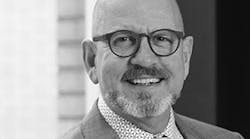I always begin my projects by asking clients what needs to happen in a space and what they need to improve that experience. Most of us approach our work this way.
As I respond to the needs and desires expressed by clients, I remind myself that truly meaningful design thinking goes beyond merely incorporating the latest trends in workplace amenities and accessories. As a profession, we need to avoid falling prey to these trends, which can be akin to fashion cycles for ready-to-wear clothing: wearable after one season only—or for as long as everyone else is buying and wearing it. Instead, our workplace solutions must be strategic and customized to solve each client’s unique challenges—with a timelessness and flexibility that will accommodate their dynamic needs well into the future.
Over the last few years, workplace strategists and designers have developed incredibly valuable foundational workplace strategies. One example is our efforts to help clients recognize the importance of work-life balance and the well-being of the people who inhabit a space. These noble, overarching principles are propelling our profession forward in our efforts to create interior environments that respect the occupants and accommodate their physical and emotional needs, learning differences, work abilities, processes, and desired personal and professional outcomes. We all want to create these environments, which result in happy, healthy, safe, and more productive occupants while providing considerable value for the enterprises that employ these people. And, regardless of the client type or specific activities taking place within a space, I would venture to say that these ideas can be applied across the board to help satisfy any of our clients’ aspirations or desired results.
As designers, though, we need to remember that these new ideas are just part of our toolkits for solution making—not the lone tool. We shouldn’t approach each new project with the goal of simply using “the new great idea” as the guide for making decisions. The new trend may very well end up being a part of an overall workplace solution, but before we apply this idea, we first need to understand the client’s program needs, workflows, brand experiences, and culture. What is the ROI this organization is looking for and how can we help? It is our responsibility to extract this information in order to create the most strategic, informed design solutions.
Great design stems from creative problem solving that occurs during the process of carrying out a project. However, it only happens after we listen to and truly connect with our clients. We need to know how their people—individually and collectively—think, feel, and process their day-to-day work and interactions. What are their needs, aspirations, pain points, and measures of success?
I challenge all of us to listen more and talk less. Speak to our clients, not at them. We ultimately are the people who design the space, create new solutions, and meet client needs yet to be imagined. And it is our responsibility to continuously push forward to develop innovative ideas and foundational strategies for advancing the workplace. But as we do this, we need to, first and foremost, always consider the people for whom we are designing. We need to understand their individual needs and goals as the drivers for true innovation and creative solution making.
When our design and problem-solving skills are client-focused, our solutions will never be “one size fits all.” Anyone who buys Levi’s jeans knows that one size does not really fit all—even for those who are that “one” size. For all the hypothesizing about the future and the ideals of what life will be, the answers ultimately still exist within our clients’ experiences: their workflow, truths, needs, and desires—which at the end of the day can feel messy, complex, raw, and granular. And they are changing faster than any trend we can imagine.
We need to become the great interpreters who bring our creativity, experience, and knowledge of current trends to each client. These are the filters we will use to customize our designs to solve each client’s unique problems and surpass their expectations. When we do this, we will provide more value and endear ourselves to clients in a manner that never goes out of fashion.
Tom Marquardt, IIDA, SBID, AMA-EC, passionately believes in a design philosophy rooted in interdisciplinary design, collaboration, and mentorship. He is an established design leader who has acquired more than 30 years of experience from his namesake studio, marquardt+. In his current role as director of Interiors at HOK, he engages clients and project teams to explore dynamic, client-driven design solutions, a hallmark of his approach.


